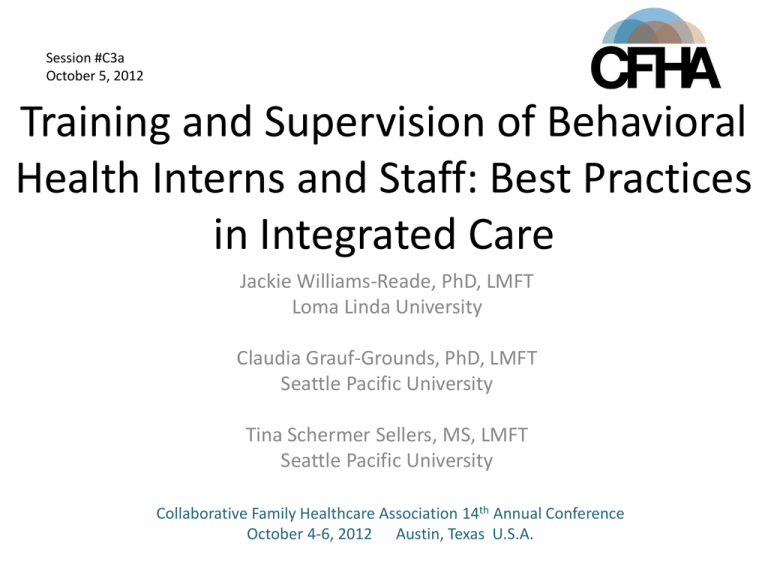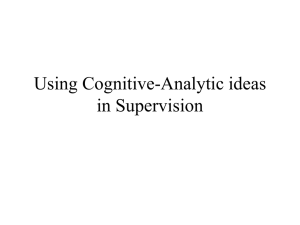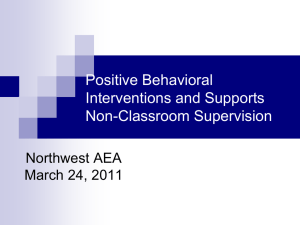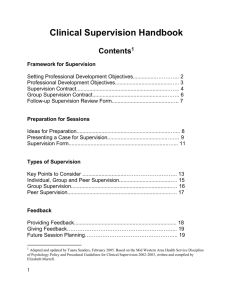Title of Presentation - Collaborative Family Healthcare Association
advertisement

Session #C3a October 5, 2012 Training and Supervision of Behavioral Health Interns and Staff: Best Practices in Integrated Care Jackie Williams-Reade, PhD, LMFT Loma Linda University Claudia Grauf-Grounds, PhD, LMFT Seattle Pacific University Tina Schermer Sellers, MS, LMFT Seattle Pacific University Collaborative Family Healthcare Association 14th Annual Conference October 4-6, 2012 Austin, Texas U.S.A. Faculty Disclosure I/We have not had any relevant financial relationships during the past 12 months. Objectives • Describe typical challenges experienced by trainees and supervisors • Explore best practices of clinical supervision in an integrated care setting • Outline methods of supervision to help facilitate the management of the physician, patient, and supervisee relationship • Discuss how to identify and improve medical cultural competencies and relationship-building skills that are critical for supervisees in integrated care Audience Poll • • • • • Supervisor/Supervisee? Behavioral health or Medical? Primary or specialty care? New supervisor or supervising for 5+ years? Typical struggles? Supervision Best Practice The quality of the relationship White and Russell (1995) found that a supervisorsupervisee relationship that is deemed successful by supervisees includes: • Warmth • Support • Humor • Genuineness These factors are crucial in building a trusting relationship that will allow supervisees to reveal their mistakes, uncertainties, and personal issues. Reflect on your past/present Supervision experiences Did they/do they include?: • Warmth • Support • Humor • Genuineness Integrated Care Case Example Domains of Supervision - Basic Clinical – assessment & intervention Professional – supervision, ethical care by discipline, record keeping Self-of-therapist – personal reactions Domains of Supervision – Integrated Care Clinical – cross-disciplinary assessments & interventions Professional – multidisciplinary concerns, communication/collaboration w/ other disciplines, ethical care, EHR Self-of-therapist – personal reactions Best Practices: Clinical Domain • Learn about medical diagnosis, proper assessments, and interventions • Continue to be curious about biopsychosocial and spiritual dimensions of each clinical case • Recognize clinical care may be for the physicians/staff and not just the patients • Discuss if clinical care is limited due to “organizational” issues (e.g., continuity of care) Best Practices: Professional Domain • Assess for relationships among staff and “culture” of healthcare setting • Encourage personally connecting to each staff person • Train providers in brief consultation • Train to do brief SOAP-note, EHR entries Best Practices: Self-of-Therapist • Be curious about how contextual influences are affecting clinical care & professional interdisciplinary relationships • Ask questions about how “case” or professional relationship is similar/different from clinician’s own upbringing • Model “thinking out loud” in conversations Overall Best Practice: Match supervision to the “Integrated Care Culture” * 1 - Minimal 2 – Basic Collaboration at a Distance 3 – Basic Collaboration on Site 4 – Close Collaboration in a Partly Integrated System 5 – Close Collaboration in a Fully Integrated System *Select the type and level of supervision for the specific medical environment and setting Doherty WJ, McDaniel SH & Baird MA. Five levels of primary care/behavioral healthcare collaboration. Behavioral Healthcare Tomorrow, 1996; 5(5):25–27. Questions? References • Briggs, J.R. & Miller, G. (2005). Success Enhancing Supervision. Journal of Family Psychotherapy, 16, 199-222. • Dobmeyer, A.C., Rowan, A. B., Etherage, J.R., & Wilson, J.R. (2003). Training psychology interns in primary behavioral health care. Professional Psychology: Research and Practice, 34, 586-594. • Doherty, W.J., McDaniel ,S.H. & Baird, M.A. (1996). Five levels of primary care/behavioral healthcare collaboration. Behavioral Healthcare Tomorrow, 5(5), 25–27. • Edwards ,T.M. & Patterson, J.E.. (2006). Supervising family therapy trainees in primary medical settings: Context matters. Journal of Marital and Family Therapy, 32, 33–43. • Gawinski, B. A., Edwards, T. M., & Speice, J. (1999). A family therapy internship in a multidisciplinary healthcare setting: Trainees’ and supervisor’s reflections. Journal of Marital and Family Therapy, 25, 469–485. • Hoge, M.A., Migdole, S., Farkas, M.S., Ponce, Al.N.,& Hunnicutt, C. (2011). Supervision in public sector behavioral health: A review. The Clinical Supervisor 30, 183-203. • Pratt, K.S. & Lamson, A.L. (2012). Supervision for the integrated behavioral health provider. In R. Curtis, & E. Christian (Eds.) Integrated care: Applying theory to practice. (pp. 259-267). Hoboken: Routledge. • White & Russell, (1995). The essential elements of supervisory systems; A modified Delphi study. Journal of Marital and Family Therapy, 21, 33-53. Session Evaluation Please complete and return the evaluation form to the classroom monitor before leaving this session. Thank you!











